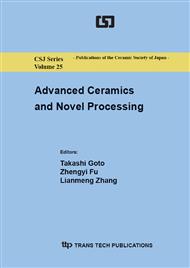[1]
L.J. Gibson, M.F. Ashby, Cellur Solids: Structure and Properties, Cambridge Univ. Press, Cambridge, 1997.
Google Scholar
[2]
M. Hakamada, Y. Yamada, T. Nomura, H. Kusuda, Y. Chen, M. Mabuchi, Effect of sintering temperature on compressive properties of porous aluminum produced by spark plasma sintering, Mater. Trans. 2 (2005) 186-188.
DOI: 10.2320/matertrans.46.186
Google Scholar
[3]
M. Hakamada, Y. Yamada, T. Nomura, H. Kusuda, Y. Chen, M. Mabuchi, Fabrication of porous aluminum sintering by spacer method consisting of spark plasma sintering and sodium chloride dissolution, Mater. Trans. 12 (2005) 2624-2628.
DOI: 10.2320/matertrans.46.2624
Google Scholar
[4]
J. Banhart, Manufacture, Characterisation and Application of Cellular Metal: Metal Foams, Progress in Materials Science 46 (2001) 559 – 632.
DOI: 10.1016/s0079-6425(00)00002-5
Google Scholar
[5]
T. Miyoshi, M. Itoh, S. Akiyama, A. Kitahara, ALPORAS Aluminum foam: Process, properties and applications, Adv. Eng. Mater. 4 (2000) 179-183.
DOI: 10.1002/(sici)1527-2648(200004)2:4<179::aid-adem179>3.0.co;2-g
Google Scholar
[6]
M. Kobashi, N. kanetake, Processing of intermerallic foam by combustion reaction, Adv. Eng. Mater. 4 (2002) 745-747.
DOI: 10.1002/1527-2648(20021014)4:10<745::aid-adem745>3.0.co;2-u
Google Scholar
[7]
A.E. Simone, L.J. Gibson, Efficient structural components using porous metals, Mater Sci and Eng A 229 (1997) 55-62.
Google Scholar
[8]
C.E. Wen, M. Mabuchi, Y. Yamada, K. Shimojima, Y. Chino, H. Hosokawa, T. Asahina, Processing of fine-grain Al foam by SPS, J. Mater. Sci. Lett. 22 (2003) 1407-1409.
DOI: 10.1023/a:1025751128104
Google Scholar
[9]
C.E. Wen, M. Mabuchi, Y. Yamada, K. Shimojima, Y. Chino, T. Asahina, Processing of biocompatible porous Ti and Mg, Scr. Mater. 45 (2001) 1147-1153.
DOI: 10.1016/s1359-6462(01)01132-0
Google Scholar
[10]
Y.Y. Zhao, D.X. Sun, A novel sintering-dissolution process for manufacturing Al foams, Scr. Mater. 44 (2001) 105-110.
DOI: 10.1016/s1359-6462(00)00548-0
Google Scholar
[11]
C. Gaillard, J. F. Despois, A. Mortensen, Processing of NaCl powders of controlled size and shape for the microstructural tailoring of aluminiun foams, Mater. Sci. Eng. A, 374 (2004) 250-262.
DOI: 10.1016/j.msea.2004.03.015
Google Scholar


